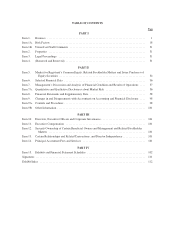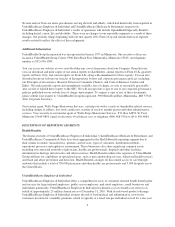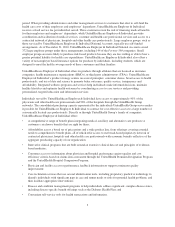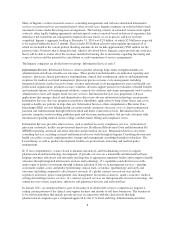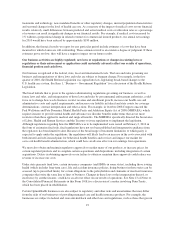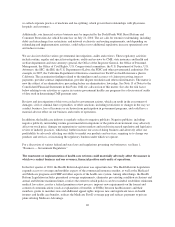United Healthcare 2010 Annual Report Download - page 12
Download and view the complete annual report
Please find page 12 of the 2010 United Healthcare annual report below. You can navigate through the pages in the report by either clicking on the pages listed below, or by using the keyword search tool below to find specific information within the annual report.
and rules, our business, financial condition and results of operations could be materially adversely affected. See
Item 1A, “Risk Factors” for a discussion of the risks related to compliance with federal and state laws and
regulations.
Health Care Reforms
The Health Reform Legislation expands access to coverage and modifies aspects of the commercial insurance
market, as well as the Medicaid and Medicare programs, CHIP and other aspects of the health care system.
Certain provisions of the Health Reform Legislation have already taken effect, and other provisions become
effective at various dates over the next several years. The Department of Health and Human Services (HHS), the
Department of Labor (DOL) and the Treasury Department have issued regulations (or proposed regulations) on a
number of aspects of Health Reform Legislation, but we await final rules and interim guidance on other key
aspects of the legislation.
Certain aspects of the Health Reform Legislation are also being challenged in federal court, with the proponents
of such challenges seeking to limit the scope of or have all or portions of the Health Reform Legislation declared
unconstitutional. For example, on January 31, 2011, in a case brought on behalf of 26 state attorneys general and/
or governors and certain other parties, the United States District Court for the Northern District of Florida ruled
that the provision in the Health Reform Legislation that requires individuals to purchase health insurance (or be
subject to penalties), along with the entire legislation, is unconstitutional. The United States District Court for the
Eastern District of Virginia has held that the individual mandate and certain related provisions are
unconstitutional, but without declaring the entire legislation unconstitutional. In contrast, federal district court
judges in Virginia and Michigan have upheld the constitutionality of the individual mandate and the Health
Reform Legislation. There are other cases challenging aspects of the Health Reform Legislation that remain
pending and have not yet been decided. Judicial proceedings are subject to appeal and could last for an extended
period of time, and we cannot predict the results of any of these proceedings. Congress may also withhold the
funding necessary to implement the Health Reform Legislation, or may attempt to replace the legislation with
amended provisions or repeal it altogether.
The following outlines certain provisions of the Health Reform Legislation that have taken or will take effect in
the coming years, assuming the legislation is implemented in its current form.
Effective 2010: The Health Reform Legislation mandated the expansion of dependent coverage to include
adult children until age 26; eliminated certain annual and lifetime caps on the dollar value of certain
essential health benefits; eliminated pre-existing condition limits for enrollees under 19; prohibited certain
policy rescissions; prohibited plans and issuers from charging higher cost sharing (copayments or
coinsurance) for emergency services that are obtained out of a plan’s network; and included a requirement
to provide coverage for preventive services without cost to members (for non-grandfathered plans).
The Health Reform Legislation also mandated certain changes to coverage determination and appeals
processes, including expanding the definition of “adverse benefit determination” to include rescissions;
extending external review rights of adverse benefit determinations to insured and self-funded plans;
requiring urgent care coverage determinations to be made and communicated within 24 hours; and
improving the clarity of and expanding the types of information in adverse benefit determination notices.
Effective 2011: Beginning in 2011, commercial fully insured health plans in the large employer group, small
employer group and individual markets with medical loss ratios below certain targets (85% for large
employer groups, 80% for small employer groups and 80% for individuals, calculated under the definitions
in the Health Reform Legislation and regulations) will be required to rebate ratable portions of their
premiums to their customers annually. Rebate payments, if any, for 2011 would be made in mid 2012. A
state can request a waiver of the individual market medical loss ratio for up to three years if the state
petitions and provides to HHS certain supporting data, and HHS determines that the requirement is
disruptive to the market in that state. In addition, effective in 2011, the Health Reform Legislation mandates
consumer discounts of 50% on brand name prescription drugs and 7% on generic prescription drugs for
Part D plan participants in the coverage gap.
10


